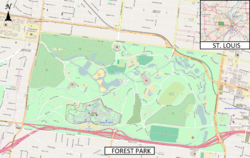
Jewel Box (St. Louis)
This article includes a list of references, related reading, or external links, but its sources remain unclear because it lacks inline citations. (January 2024) |
Jewel Box | |
 | |
| Location | Forest Park St. Louis, Missouri, United States |
|---|---|
| Coordinates | 38°38′07″N 90°16′49″W / 38.63528°N 90.28028°W |
| Built | 1936 |
| Architect | William C. E. Becker |
| Architectural style | Art Deco |
| NRHP reference No. | 00000147 |
| Added to NRHP | March 14, 2000 |

The Jewel Box (also known as the St. Louis Floral Conservatory and the City of St. Louis Floral Display House) is a greenhouse located in Forest Park, St. Louis, Missouri at the intersection of Wells and McKinley Drives. It now serves as a public horticultural facility and is listed on the National Register of Historic Places (NRHP).

It was designed by architect William C. E. Becker and built in 1936 by the Robert Paulus Construction Company. It consists of five stepped, composition-covered wood roofs with clerestories, rather than a regular glass roof, in order to prevent damage from frequent hailstorms.

In 2002, just two years after being listed in the National Register of Historical Places (NHRP), the Jewel Box underwent a $3.5 million renovation.

History
In 1913, Nelson Cunliff became Commissioner of Parks and Recreation for St. Louis City. Public floral conservatories gained popularity in the city in the 1910s, when pollution and smog threatened much of the city's flora. Due to high levels of smoke and soot within the city, he began a survey to determine which plants could survive the conditions. He later asked city gardener John Moritz, who was in charge of the city's greenhouses, to set up a display greenhouse for public enjoyment to showcase various plants that could survive. It is said that someone called the displays "like a jewel box", hence the name. In 1933, Bernard Dickmann became Mayor of St. Louis and decided to build a new facility on a 17-acre site in Forest Park. The building cost about $117,000, with about 45% coming from Public Works Administration funds, and William C. E. Becker, then Chief Engineer of Bridges and Buildings for the city, was assigned to design the building. Construction began on December 12, 1935, and the facility opened on November 14, 1936.

After city budget cuts at the end of the 20th century, local volunteer groups formed partnerships with the city Department of Parks and Recreation to maintain the landscape setting surrounding the Jewel Box.

Construction
Designed by city engineer William C.E. Becker and built by contractor Robert Paulus Construction Co., construction of the Jewel Box began late in 1935 and lasted just under a year. Becker studied climate patterns to produce a design measuring 144 feet (43.9 m) long and 55 feet (16.8 m) wide, containing about 7,500 square feet (696.8 m2) of floor space. The Jewel Box consists of 16,664 square feet (1,548.1 m2) of plate glass in over 4,000 panes, set in wood and wrought iron supports. The unconventional, cantilevered, vertical glass walls rise 50 feet high. Most of the glass is framed by copper with a verdigris patina. The Jewel Box is supported by eight fixed arches carrying the structure's weight. There are also triangular trusses between every other arch. The ceiling is composed of wood planking. The Jewel Box's entrance is a vestibule made of limestone. Inside the greenhouse, there is a concrete-floored balcony located across the south end. The design also included three reflecting pools south of the structure, along with a network of footpaths connecting the greenhouse to Forest Park's existing pedestrian routes.

The Art Deco-style greenhouse structure was designed to meet 3 major criteria: to minimize risk from hail, admit the greatest amount of sunlight, and minimize maintenance costs. The design was unconventional for the time. Unlike traditional greenhouses, all of the horizontal surfaces were metal rather than glass. The value of this innovative design was proven during a 1938 hailstorm that broke more than 1,000 glass panes in adjacent, glass-roofed greenhouses while the Jewel Box stood undamaged.

Renovations
In 1993, the City of St. Louis began work on a master plan to renew Forest Park and preserve it for future users, while meeting the needs of present families. The city involved thousands of people in the two-year planning process to create the Master Plan, taking extra care to ensure that the plan truly reflected the desires of everyone involved, resulting in: Restoring the Glory; A Campaign for Forest Park. The Campaign was adopted in 1995 and would be enacted over the following 10 years, costing $86 million, with hopes that all major construction be complete by the 100th anniversary of the 1904 St. Louis World's Fair.

The Master Plan included plans to upgrade the Jewel Box and bring it back to life. ABS Consulting was selected to provide structural repairs for the Jewel Box. The greenhouse was designed by William C.E. Becker who would later help found Becker, Becker & Pannell, the same engineering firm acquired early in 2001 by ABS Consulting. This truly brought the landmark full circle, with the engineering staff assigned to the project including those formerly associated with Becker, Becker & Pannell keeping William C.E. Becker's original ideas alive.

In 2002, a $3.5 million, year-long renovation of the building was completed. This renovation included removing all of the old vegetation and reconfiguring the planting areas to the sides of the building, leaving the interior free and flooding the Jewel Box with sunlight. The interior area gained a large fountain and water feature that can be removed for weddings and other events and large pots that line both sides of the pond and baskets of plants that hang from the ceiling. Floral display areas were improved along with the introduction of a catering area to better facilitate weddings and other large events.

During the renovation, the Jewel Box's mechanical systems were replaced and a new heating and air conditioning system was installed to maintain comfortability inside during both the coldest and hottest weather extremes.

Present day
Today the Jewel Box is an aged St. Louis treasure that has been restored to its former glory. It remains open to the public. There are special floral shows at Christmas, early spring, Easter, Mother's Day, summer, and fall. It has tropical trees, foliage plants, flowers, a new water feature, and a fountain all year round.

See also
- 1939 St. Louis smog
- Climatron, a large geodesic dome greenhouse begun in the late 1950s in St. Louis, at the Missouri Botanical Garden
References
- Jewel Box
- Forest Park - Jewel Box | TCLF
- "Restoring the glory". St. Louis Commerce. April 1998. p. 56. ProQuest 211174540.
- "Engineering firm with a history selected for Jewel Box work". St. Louis Business Journal. Vol. 22, no. 7. 26 October 2001. p. 54. ProQuest 228323068.
External links
- Buildings and structures completed in 1936
- Agricultural buildings and structures on the National Register of Historic Places in Missouri
- Buildings and structures in St. Louis
- Art Deco architecture in Missouri
- Forest Park (St. Louis)
- Greenhouses in the United States
- Tourist attractions in St. Louis
- Agricultural buildings and structures in Missouri
- National Register of Historic Places in St. Louis
- 1936 establishments in Missouri
See what we do next...
OR
By submitting your email or phone number, you're giving mschf permission to send you email and/or recurring marketing texts. Data rates may apply. Text stop to cancel, help for help.
Success: You're subscribed now !

